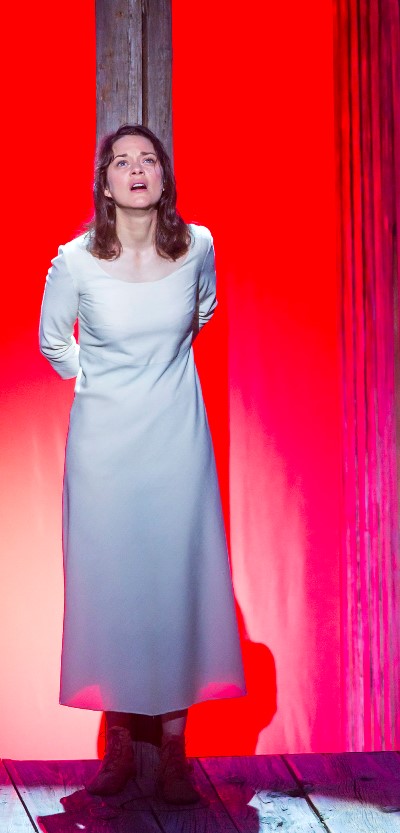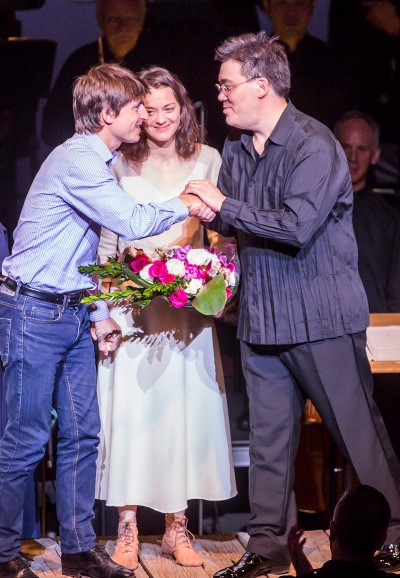New York Aisle: Philharmonic tops off season with rare bounty of Honegger’s ‘Joan of Arc’
 Review: New York Philharmonic conducted by Alan Gilbert, performing Arthur Honegger’s dramatic oratorio “Jeanne d’Arc au bûcher.”
Review: New York Philharmonic conducted by Alan Gilbert, performing Arthur Honegger’s dramatic oratorio “Jeanne d’Arc au bûcher.”
By Susan Elliott
NEW YORK – From his earliest days as music director of the New York Philharmonic, Alan Gilbert has indulged New York audiences with an end-of-the-season extravaganza, from a semi-staging of Ligeti’s “Le Grand Macabre” in Avery Fisher Hall in 2010 to a three-orchestra, three-conductor modern-music blowout several years later in the Park Avenue Armory called, as befits that cavernous, in-the-round space, “Philharmonic 360.”
This year’s offering was “Jeanne d’Arc au bûcher” (Joan of Arc at the Stake), performed June 10-13 (I saw it June 12), a “dramatic oratorio,” composed in 1935 (updated in 1944), by Arthur Honegger that is rarely performed if only because of the magnitude of forces: adult chorus, children’s chorus, 11 sung roles, two lead actors and several other speakers, plus full orchestra with two pianos, ondes Martenot, a trio of saxophones, and other assorted curiosities.
 If that sounds like the kitchen sink, it is. The production, in its American premiere, originated at the Seiji Ozawa Festival Matsumoto in 2012, staged by French director-writer Côme de Bellescize. Honegger and librettist Pierre Cauchon unfold the story in flashbacks that start from Joan’s celestial emergence from the stake, loop around to the events that got her there, and then back to the stake and her spiritual life again.
If that sounds like the kitchen sink, it is. The production, in its American premiere, originated at the Seiji Ozawa Festival Matsumoto in 2012, staged by French director-writer Côme de Bellescize. Honegger and librettist Pierre Cauchon unfold the story in flashbacks that start from Joan’s celestial emergence from the stake, loop around to the events that got her there, and then back to the stake and her spiritual life again.
She is prompted to recall and comment upon them by Brother Dominique, a character who arrives at the second of the work’s 11 scenes with a large book under his arm. Whether it’s in fact her story, or a bible, or an historic accounting of the 100 Years War, we’ll never know—it’s one of many unanswered questions in a libretto rife with metaphor, symbolism and, occasionally, biting satire.
Cauchon’s Joan is a naïve country girl; we are only privy to the brazen war hero in her passionate declamations of spiritual inspiration, delivered in conjunction with and response to the surrounding musical forces. A performance will succeed or fail on the strength of its central character, and here actress Marion Cotillard delivered the goods magnificently, her plaintive, beautifully accented French (with English surtitles) spoken words as musical as those sung around her. Gently miked, she managed to rise above Honegger’s ever evolving, ever recurring huge waves of orchestral and choral sound, while being an equally convincing innocent in the work’s occasional quieter moments.
Cauchon is said to have specified the kinds of music, even instruments, that should accompany the text, and Honegger has obliged with a wild variety, from plainchant to nursery ditties to eerie, suspense-building film score to jazz to full, drippingly romantic symphonic wash.
 With the adult chorus on risers at the back of the stage, dimly lit in off-white robes, most of the action took place on a raised platform at center stage, where Joan and Brother Dominic were stationed.
With the adult chorus on risers at the back of the stage, dimly lit in off-white robes, most of the action took place on a raised platform at center stage, where Joan and Brother Dominic were stationed.
Other characters, including Porcus the Pig and his flock of sheep, assorted subjects of the royal court, and military and religious types, careered about the perimeter of the stage. Most of the Philharmonic was situated at audience level in a makeshift pit, crafted from the first few rows of orchestra seats.
The staging appears to have followed the libretto, swinging from comic, chaotic and fully populated scenes to Joan alone, Joan with Dominic (Éric Génovèse), Joan in conversation with her voices Marguerite, Catherine, and, in the final scenes, the Virgin (Simone Osborne, Faith Sherman, and Erin Morley, all singing from the back risers), Joan at trial, and so on.
This last, titled “Joan Given Up to the Beasts,” features Porcus and his flock of humans in sheep’s clothing as both judge and jury, collectively condemning her as a sorcerous, heretical witch. As Porcus, tenor Thomas Blondelle relished the spotlight, cavorting about the stage in his pink piggy outfit, almost as much of an ass as the court recorder, here played by Narrator Christian Gonon with a donkey’s head over his circus ring-master costume. Vocally, Blondelle (also in the roles of a Priest, John of Luxembourg, Herald I, and the Clerk) put his clear, sweet tenor through its paces, whether spitting out Latin nonsense recitative-patter-song style as the pig-judge, or delivering plain chant as the priest.
 Singing from memory, the New York Choral Artists (Joseph Flummerfelt, director) and, especially, the Brooklyn Youth Chorus (Dianne Berkun- Menaker, director) finessed their substantial musical and dramatic roles well, and other, smaller parts were taken by Steven Humes and Thijs Beuming. Save for the choruses and Erin Morley, all were making their Philharmonic debuts.
Singing from memory, the New York Choral Artists (Joseph Flummerfelt, director) and, especially, the Brooklyn Youth Chorus (Dianne Berkun- Menaker, director) finessed their substantial musical and dramatic roles well, and other, smaller parts were taken by Steven Humes and Thijs Beuming. Save for the choruses and Erin Morley, all were making their Philharmonic debuts.
Honegger has followed the libretto’s moods and antics to the letter, although the former aspect can get a bit tiresome after a while (piccolos for comic, ondes Martenon for creepy, saxophones for sleazy, etc.).
Even at a mere 80 minutes (no intermission here), the piece has some dead moments between its eerie start and ear-splitting penultimate measures. For the most part, Gilbert kept balances in check, save for the brass occasionally covering the chorus; musically, this was not a particularly inspired reading of Jeanne (although the audience was wild about it). No doubt inspiration occurred on Jan. 1, 1948, when the New York Philharmonic introduced the piece to American audiences for the first time under Charles Munch. Now that would be a hard act to follow.
Susan Elliott, former performing arts critic for the Atlanta Journal Constitution, edits MusicalAmerica.com.
Tags: Alan Gilbert, Arthur Honegger, Booklyn Youth Chorus, Côme de Bellescize, Marion Cotillard, New York Choral Artists, New York Philharmonic, Pierre Cauchon


The article contains an amusing error. The librettist for Honegger’s oratorio was Paul Claudel, not Pierre Cauchon. Cauchon was one of the judges at Joan’s trial.